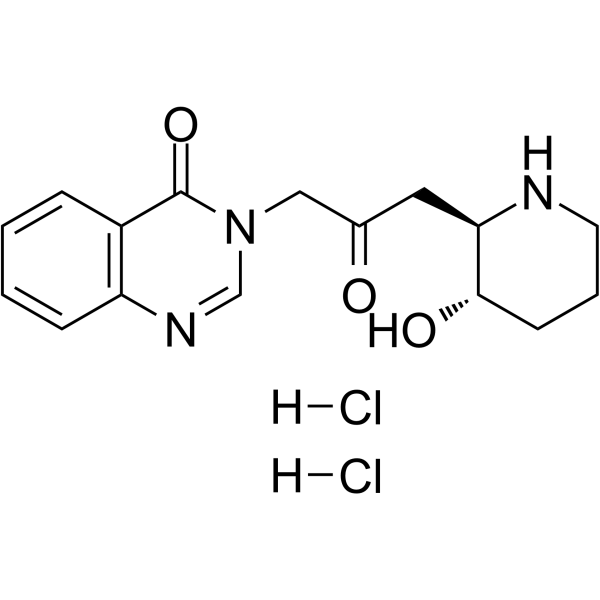
Febrifugine dihydrochloride
CAS No. 32434-42-7
Febrifugine dihydrochloride( Atensil | Febrifugine dihydrochloride | ISF-2123 | Pildralazine dihydrochloride | Propyldazine hydrochloride )
Catalog No. M29036 CAS No. 32434-42-7
Febrifugine dihydrochloride is a biochemical with therapeutic activity regarding malaria, cancer, fibrosis and inflammatory diseases.
Purity : >98% (HPLC)
 COA
COA
 Datasheet
Datasheet
 HNMR
HNMR
 HPLC
HPLC
 MSDS
MSDS
 Handing Instructions
Handing Instructions
| Size | Price / USD | Stock | Quantity |
| 5MG | 127 | In Stock |


|
| 100MG | Get Quote | In Stock |


|
| 200MG | Get Quote | In Stock |


|
| 500MG | Get Quote | In Stock |


|
| 1G | Get Quote | In Stock |


|
Biological Information
-
Product NameFebrifugine dihydrochloride
-
NoteResearch use only, not for human use.
-
Brief DescriptionFebrifugine dihydrochloride is a biochemical with therapeutic activity regarding malaria, cancer, fibrosis and inflammatory diseases.
-
DescriptionFebrifugine dihydrochloride is a biochemical with therapeutic activity regarding malaria, cancer, fibrosis and inflammatory diseases.
-
In Vitro——
-
In Vivo——
-
SynonymsAtensil | Febrifugine dihydrochloride | ISF-2123 | Pildralazine dihydrochloride | Propyldazine hydrochloride
-
PathwayMicrobiology/Virology
-
TargetParasite
-
RecptorParasite
-
Research Area——
-
Indication——
Chemical Information
-
CAS Number32434-42-7
-
Formula Weight374.26
-
Molecular FormulaC16H21Cl2N3O3
-
Purity>98% (HPLC)
-
SolubilityIn Vitro:?DMSO : 8.33 mg/mL (22.26 mM)
-
SMILESCl.Cl.O[C@H]1CCCN[C@@H]1CC(=O)Cn1cnc2ccccc2c1=O
-
Chemical Name——
Shipping & Storage Information
-
Storage(-20℃)
-
ShippingWith Ice Pack
-
Stability≥ 2 years
Reference
molnova catalog



related products
-
Tafenoquine
Tafenoquine (SB-252263, Tafenoquine, WR 238605) is a long-acting, orally active anti-malarial agent to prevent malaria that is holoendemic for Plasmodium falciparum.
-
Piperaquine tetrapho...
Piperaquine tetraphosphate tetrahydrate is a potent anti-parasites agent.
-
SJ-733
SJ-733 (SJ000557733;SJ-557733) is an anti-malarial compound that targets ATP4, a cation-transporting ATPase responsible for maintaining low intracellular Na(+) levels in the parasite.



 Cart
Cart
 sales@molnova.com
sales@molnova.com


